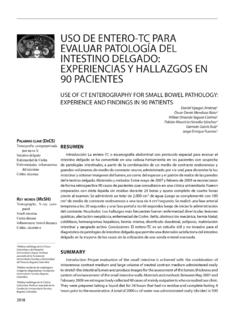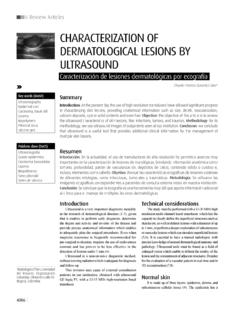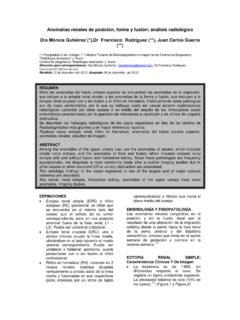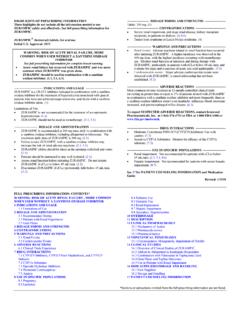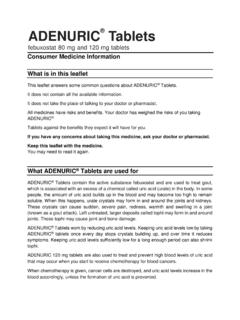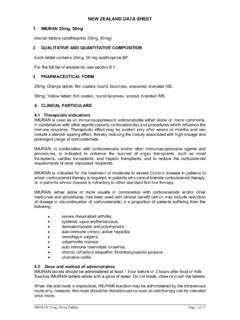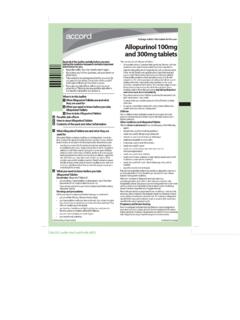Transcription of DIAGNOSTIC APPROACH TO MYELOPATHIES - CIR
1 Review articlesRev Colomb Radiol. 2011; 22:(3):1-211 DIAGNOSTIC APPROACH TO MYELOPATHIESENfOquE DIAGN STICO DE LAS MIELOPAT ASAna Mar a Granados S nchez1 Lina Mar a Garc a Posada2C sar Andr s Ortega Toscano2 Alejandra L pez L pez2 SUMMARY Myelopathy is a broad term that refers to spinal cord involvement of multiple etiologies. Spinal cord diseases often have devastating consequences, ranging from quadriplegia and paraplegia to severe sensory deficits due to its confinement in a very small area. Many of these diseases are potentially reversible if they are recognized on time, hence the importance of recognizing the significance of magnetic resonance imaging when approaching a multifactorial disease considered as one of the most critical neurological emergencies, where prognosis depends on an early and accurate a es un t rmino general que hace referencia a la afectaci n medular por m ltiples etiolog as.
2 Las enfermedades de la m dula espinal tienen con frecuencia consecuencias devastadoras: pueden producir cuadriplej a, paraplej a y d ficits sensitivos graves debido a que la m dula espinal est contenida en un canal de rea peque a. Muchas de estas enfermedades de la m dula espinal son reversibles si se reconocen con oportunidad, por ello los radi logos deben sensibilizarse sobre la importancia de las im genes por resonancia magn tica en el enfoque de una patolog a multifactorial en la cual el pron stico depende del diagn stico precoz y preciso, y por ello constituyen una de las urgencias neurol gicas m s term myelopathy describes pathologic conditions that cause spinal cord, meningeal or perimeningeal space damage or dysfunction. Traumatic injuries, vascular diseases, infections and inflammatory or autoimmune processes may affect the spinal cord (1) due to its confinement in a very small space.
3 Spinal cord injuries usually have devastating consequences such as quadriple-gia, paraplegia and severe sensory deficits. The history, an adequate neurological ex-amination and the study of the cerebrospinal fluid (CSF) guide the diagnosis of spinal cord injuries. However, imaging is of great importance in order to home in on the diagnosis and classify the etiol-ogy appropriately (2-3).Many of the processes affecting the spinal cord may be reversible if recognized and treated early. The vast majority of spinal cord diseases may be treated medically, with surgical treatment reserved for compressive disorders, which constitute a neurological emergency (2). This paper reviews the different etiologies, divided into compressive and non-compressive. Definition and clinical pictureIt is important not to mistake myelopathy for myelitis.
4 Although both terms refer to spinal Key words (MesH) Spinal cordSpinal cord diseasesMagnetic resonance imaging Palabras clave (decs)M dula espinalEnfermedades de la m dula espinal Imagen por resonancia magn tica 1 Neuroradiologist, Fundaci n Valle de Lili, Cali, Colombia. 2 Radiology resident physician, Universidad CES, Medell n, APPROACH to MYELOPATHIES . Granados A; Garc a L; Ortega C; L pez A2 Posterior spinal cord syndrome: posterior columns (vita-min B12 or copper deficiency). Central syndrome: spino-thalamic crossing, cortico-spinal and autonomic tracts (syringomyelia, neuromyelitis optica). Medullary cone: sacral emerging fibres (post-viral my-elitis). Cauda equina: cauda equina nerves (acute cytomegalovi-rus infection, polyradiculits and compression) Tractopathies: selective disorders (vitamin B12 defi-ciency, paraneoplastic myelopathy and multiple sclerosis).
5 There are cases where the etiology is never identified, and they are classified as idiopathic myelopathy. In 2001, De Seze et al. found that 43% of acute MYELOPATHIES were secondary to multiple sclerosis; were due to a systemic disease; 14% to a spinal cord infarct; 6% to an infectious disease; 4% were secondary to radiation; and were idiopathic (9). Moore et al. found that in cases of non-traumatic injury, were due to cervical spondylolysis; to multiple sclerosis; to a neoplastic lesion; to motor neuron disease; and were idiopathic or of unknown etiology (10). Chronic myelopa-thies include, among others, spondylotic myelopathy, vascular malformations, retrovirus-associated myelopathy (human im-munodeficiency virus), syringomyelia, chronic myelopathy due to multiple sclerosis, combined subacute degeneration (vitamin B12 deficiency), tabes dorsalis, and familial spastic on the Sicard and Forstier classification that divides the disease into compressive and non-compressive, in relation to subarachnoid space obstruction, Table 1 shows a list of the different etiologies (2-3,11).
6 Compressive myelopathiesCompressive diseases of the spinal cord are divided into acute and chronic, including degenerative changes, trauma, tumor infiltration, vascular malformations, infections with abscess formation, and syringomyelia (Table 1). Patients with clinical findings of compressive myelopathy that show exten-sive (more than three vertebral segments) fusiform spinal cord hyperintensity in T2 weighted sequences, are often mistakenly thought to have optic neuritis, or classified as idiopathic. This delays surgical treatment when other causes such as stenosis of the spinal canal are not taken into consideration (9).Compressive disease is the main cause of myelopathy in older patients. It has a chronic course and usually does not recur (7). High intensity signals in T2 images is explained by myelomalacia, gliosis, tethering damage, vascular or inflamma-tory edema, demyelination and vacuolar changes.
7 Gadolinium enhancement is limited to the region of maximum compression (12). Kelley et al. found that none of the patients with compres-sive myelopathy improved with intravenous corticosteroids, while patients with inflammatory MYELOPATHIES did improve, invalidating the hypothesis of traumatic inflammatory compromise due to a pathological event, myelopathy has multiple etiologies, while myelitis is used to refer to inflamma-tory or infectious processes (1,4). Acute transverse myelopathy (includes non-inflammatory etiologies) and transverse myelitis have been used as synonyms in the published literature (5).Findings of spinal tract injuries, a certain degree of sensory dysfunction, or urinary retention, point to a spinal cord injury. There are certain conditions that may mimic myelopathy, such as myopathy or disorders of the neuromuscular junction, but the absence of a sensory deficit rules them out.
8 On the other hand, bilateral frontal mesial lesions may mimic myelopathy but they are associated with abulia or other signs of frontal dysfunction (6). MYELOPATHIES may have a variable course and may manifest as a single event or as a multi-phasic or recurrent disease. The latter is rare and is usually secondary to demyelinating diseases, vascular malformations of the spinal cord, or systemic diseases (4,5). The central nervous system (CNS) damage may be mono-focal as in transverse myelitis and optic neuritis, or multifocal as in acute disseminated encephalomyelitis (ADEM) (brain and spinal cord), neuromyelitis optica (optic nerve and spinal cord) and multiple sclerosis (MS) (any area of the neural axis) (4).Spinal cord pathologies may be classified as acute, subacute/intermittent (6) or chronic, depending on the time course, the extent of the involvement, the clinical picture or syndrome, or the etiology (2-4,6,7).
9 Patients with MYELOPATHIES but no evident lesions, or who present with multiple lesions of chronic appear-ance on magnetic resonance imaging, must be questioned about prior subtle symptoms (6). Acute onset that worsens within hours or days points to a spinal cord infarct or hemorrhage. When symptoms are recent, it is of paramount importance to rule out a surgical emergency. This requires immediate imaging work-up, ideally total spine magnetic resonance (MR). If there is evidence of spinal cord compression due to an acute lesion (epidural metastasis or abscess), definitive management is required in order to avoid damage or to adequately manage all other potential diagnoses. If the symptoms progress for more than three weeks, transverse myelitis is improbable, and other conditions must be considered, such as a spinal tumor, chronic compressive disease, dural arterio-venous fistula, metabolic disorder, sarcoidosis, or a degenerative process (6).
10 Spinal cord syndromes present with typical signs and symp-toms caused by a lesion of a specific tract in a specific location that may lead to the etiological diagnosis. They are classified as follows (2,6,8): Complete spinal cord: involvement of all the tracts (trauma, compression or acute transverse myelitis). Brown S quard or hemi-spinal cord syndrome: ipsilateral cortico-spinal tract, posterior columns and contralateral spinothalamic tract (multiple sclerosis and compression). Anterior spinal cord syndrome: anterior horns, cortico-spinal, spinothalamic and autonomic tracts (anterior spinal artery infarct and multiple sclerosis). Rev Colomb Radiol. 2011; 22:(3):1-213review articlesTable 1. EtiologiesCompressiveNon-compressiveDege nerativeInfectious transverse myelitis: Viral: Zoster, Ebstein-Barr, herpes simplex, cytomegalovirus, adenovirus, enterovirus, Coxsackie B, type 6 herpes virus, HIV and AIDS, HTLV I and II Bacterial: staphylococcus aureus, streptococci, mycobacteria Spirochetes: syphilis and Lyme disease fungi: cryptococcus, aspergillusAcute Disseminated Encephalitis: Demyelinating diseases Multiple sclerosis Neuromyelitis optica Eale s diseaseVascular.


